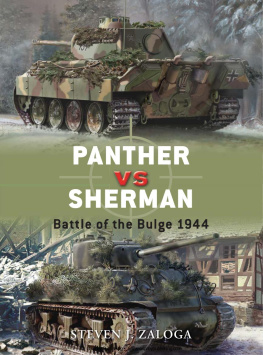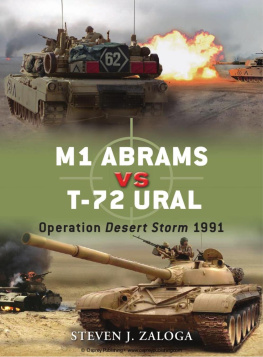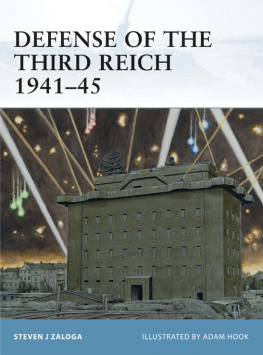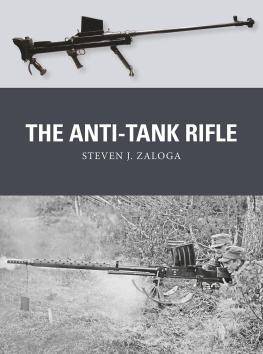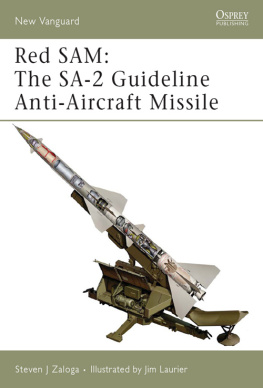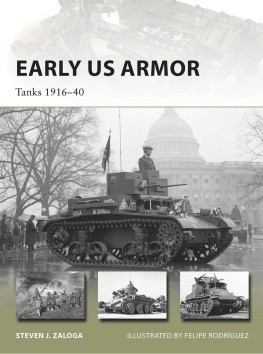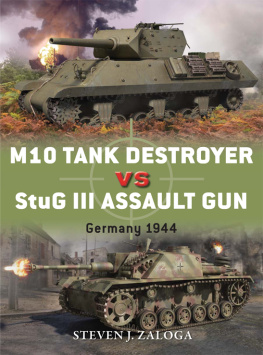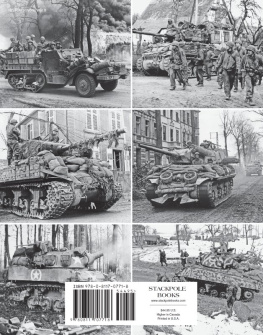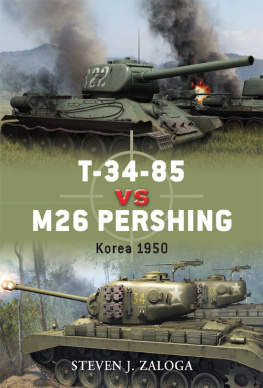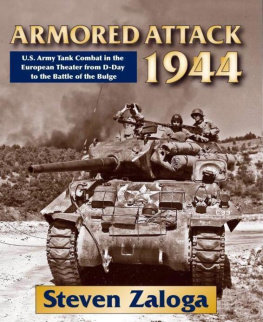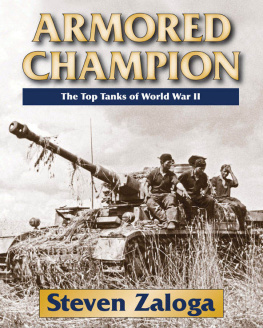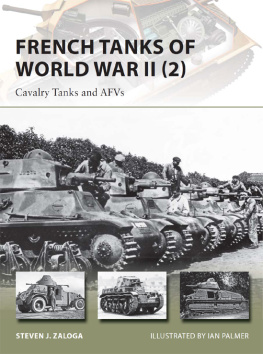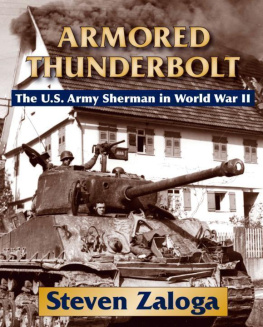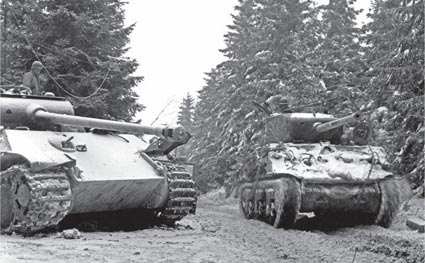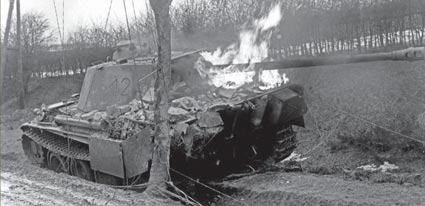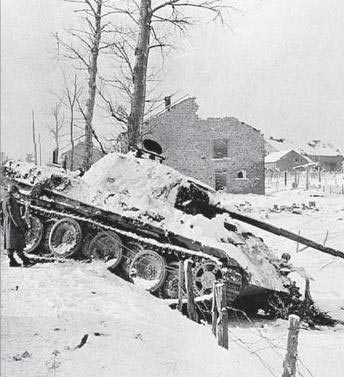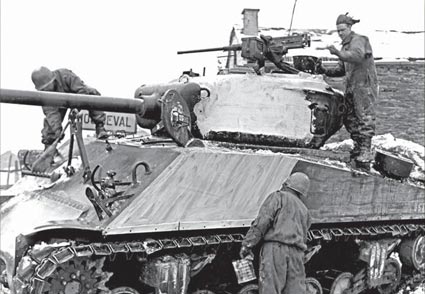INTRODUCTION
The Battle of the Bulge in December 1944January 1945 was the last great clash of armor in the West in World War II. In a desperate gamble to reverse Germanys declining fortunes, Hitler threw away his last panzer reserves in a futile effort to cripple the inexorable Allied advance. The tank fighting in the Ardennes provides an intriguing subject for Ospreys Duel series. On the face of it, the contest between Sherman and Panther seems preordained in the Panthers favor. On paper, the Panther was more than a match for the Sherman, with a much more powerful gun and much better frontal armor. Yet paper statistics do not decide the outcome of battles, and they have less effect on combat than is often assumed. Technical superiority does not necessarily translate into tactical success on the battlefield. Other factors the quality and training of soldiers, the tactics they employ, the conditions of the battlefield usually have a far greater impact than the technological balance alone. The aim of this book is to examine the battle from this perspective, pitting the US Armys M4A3 (76mm) medium tank against the German Panther Ausf. G medium tank.
Most popular accounts focus on the technological balance between tanks as the basis for comparing their prospects in battle. Yet operational research in World War II suggests otherwise. The results of these studies are not well known outside professional military circles, but they offer a sharply different view of tank-versus-tank combat in World War II. These studies suggest that the primary factor in deciding victor and vanquished in tank combat was not the technological balance, but who spotted the enemy tank first, who engaged first, and who hit first.
Many assessments of World War II tanks are based on the false notion that tankversus- tank combat was the predominant mission of tank units in World War II. This was certainly not the case of either German or American tank units in northwest Europe in 194445. Tanks were the spearhead of combined arms operations, always used in conjunction with infantry to overcome enemy defenses and to exploit breakthroughs by rapid advance. More often than not, these missions involved actions against enemy infantry. Encounters with enemy tanks, while not rare, were not a daily occurrence except in major campaigns. Tank-versus-tank fighting was the most dramatic form of tank combat in World War II but neither the most common nor the most important.
An M4A3 (76mm) of Co. C, 774th Tank Battalion, passes by a knocked-out Panther tank near Bovigny on January 17, 1945, while supporting the 83rd Division during the drive to seal the Bulge. (NARA)
The Panther tank had formidible armament and superior armor protection to the Sherman, yet ultimately its performance in the Ardennes operation was disappointing. In the hands of an experienced crew, the Panther was clearly superior to the Sherman. The victories of the occasional panzer ace could not overcome the lackluster performance of the majority of the crews. Too many of the Wehrmacht crews in the winter of 194445 were inexperienced with minimal training. In combination with the Panther's technical weaknesses its poor powertrain durability, lack of fuel, and lack of spare parts the declining quality of German tank crews resulted more frequent breakdowns which many times resulted in the loss of the tank when it could not be recovered or repaired.
Tank warfare in World War II depended upon mass as well as technical quality. The Sherman tank prevailed in the Battle of the Bulge because it was more reliable and more numerous than the Panther. The Sherman was used not only by the armored divisions, but in support of the infantry divisions as well. While it might not be equal in a duel with a Panther, the Sherman performed well enough in its more common battlefield missions.
CHRONOLOGY
1941
February
- Development of Sherman begins.
December
- Development of Panther begins.
1942
February
- Production of M4A1 (75mm) begins.
June
- Production of M4A3 (75mm) begins.
November
- Production of Panther Ausf. D begins.
1943
June
- Development of M4 with T23 (76mm) turret begins.
August
- Production of Panther Ausf. A begins.
September
- Production of Panther Ausf. D ends.
December
- Production of M4A1 (75mm) ends.
1944
January
- Production of M4A1 (76mm) begins.
March
- Production of Panther Ausf. G begins.
April
- Production of M4A3 (76mm) begins. First 76mm Shermans arrive in European Theater of Operations.
July
- Production of Panther Ausf. A ends.
August
- Production of M4A3E8 (76mm) begins.
October 11
- First draft of Ardennes plan, codenamed Wacht am Rhein, submitted to Hitler. October 22 Senior German commanders are briefed on the Ardennes plan.
November
- First German units begin moving into the Eifel for the offensive at the beginning of the month.
December
- Production of M4A3, M4A3E8 (76mm) ends.
December 16
- X-Day, start of German Ardennes offensive begins with opening barrages against forward US positions in Ardennes.
December 25
- Delivery of first M4A3E8 (76mm) to deployed unit in ETO.
1945
February
- Production of M4A3 (75mm) ends.
April
- Production of Panther Ausf G ends.
This was one of five Panthers of the first company of SS-Panzer Regt. 12 that fought their way into Krinkelt around 0730hrs on December 18. Four were knocked out by bazooka teams and antitank guns, and this vehicle escaped down the Bllingen road where it was knocked out by an M10 3-in. gun motor carriage (GMC) of the 644th Tank Destroyer Battalion around 1100hrs. It had 11 bazooka hits, several 57mm hits, and three 3-in. impacts in the rear, a testament to the Panthers formidable protection. (NARA)
This particular Panther Ausf. G of SS-Pz.Rgt. 2 was one of several lost in the fighting at Manhay on the road from Trois Ponts. It is being inspected by US troops in early January after the town was retaken. (NARA)
The crew of an M4A3 (76mm), Co. A, 774th Tank Battalion is seen here whitewashing their tank in Joubieval on January 17, 1945, while supporting the 83rd Division in counterattacks against the remnants of the Bulge.
DESIGN AND DEVELOPMENT
THE PANTHER TANK
The Panther tank had been developed in response to the tank crisis that befell the Wehrmacht during the invasion of Russia in June 1941. Further details of the Panthers early development are covered in another book in the Duel series, Panther vs T-34, Ukraine 1943.
The Panther represented a significant shift in tank design philosophy, fostered in large measure by Germanys changing military fortunes. Until 1942, German medium tanks had been similar in weight and size to their adversaries, and often lighter. The lighter armor and firepower of the panzers was not deemed tactically significant as the primary mission of the panzer divisions was offensive, to exploit breakthroughs won by the infantry, using the panzers speed and mobility. Even if not ideally suited for tankversus- tank combat, the PzKpfw III and PzKpfw IV were durable, reliable machines suitable for mobile operations. Germanys declining military prospects in 1942 shifted the emphasis away from an offensive orientation that put a premium on mobility and durability toward a more defensive orientation that depended upon overmatching Soviet tanks in firepower and protection. The focus was a new long-range 75mm gun to attrite the numerically superior enemy tank force in the flat plains of Russia. Although the original design focused on the gun, the Panther gradually crept up in weight as more armor was added: from 22 tonnes in the original 1941 designs to about 40 tonnes by the time the design entered production. Declining supplies of critical steel alloys forced the plants to rely on armor steel with a high carbon content, requiring complex interlocking plates due to welding issues. In the haste to put the design into production, insufficient attention was paid to the impact of the weight increases on the power train, and the Panther would be plagued by durability problems because its engine and final drives were better suited to the original, lighter proposals. By any other armys definition, the Panther was a heavy tank. Although originally intended to replace the existing PzKpfw III and PzKpfw IV medium tanks, its cost and complexity limited the scale of its production. By 1944, the Wehrmacht was saddled with a mixed fleet of Panthers and PzKpfw IV tanks instead of an integrated fleet, burdening the army with both logistics and training difficulties.

